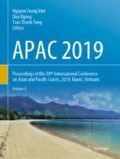Abstract
In 2011 Tohoku Region Pacific Coast Earthquake, severe damage due to Tsunami occurred along the Tohoku coast region suffered severe tsunami damage. The devastated damage was not only the inundation by tsunami but also the collapse of building and the debris by collapse of building occurred, which is including the drift of vehicles and ships. Furthermore, the damage by fire from accumulated debris also occurred. In response to such a disaster, on the tsunami disaster mitigation, it is important to take measure against buildings damage and disaster debris in addition to inundation. In this study, a tsunami numerical model considering building collapse and drifting disaster debris was applied for Owase City which is assumed to receive great damage by the Nankai Trough tsunami. For the numerical model used for the calculation, we applied the 2-dimensional tsunami numerical model which is involving the effect of collapse buildings and the debris considering various transport form developed by the authors. This proposed model is divided into two parts, one is model of the building collapse and the other is the drift of disaster debris. In order to estimate the damage of the tsunami inundation, the collapse building and the drift quantitively, we researched the effect of tsunami damage reduction due to the difference in the type of buildings structure in the coastal area. As a result, the proposed model could be obtained the following findings. 1) The proposed model can calculate inundation considering the influence of the building. 2) This model can directly evaluate damage of buildings and it can quantitatively estimate concrete damage to various scenarios of tsunami. The proposed model seems to be useful for the tsunami disaster prevention plan such as the damage estimation and mitigation.
Access this chapter
Tax calculation will be finalised at checkout
Purchases are for personal use only
Preview
Unable to display preview. Download preview PDF.
References
Chida, Y., and T. Tomita (2016): Development of Numerical Simulation Method for Debris Movement and Fire Incidence Induced by Tsunamis, P. Coast. Eng., JSCE, Vol. 72, No. 2, pp. I_421-I_426.
Goto, C., Y. Ogawa, N. Shuto, and F. Imamura (1997), Numerical Method of Tsunami Simulation with the Leap-Frog Scheme. IOC Manuals and Guides, 35, 130 pp.
Hayashi, S., A. Bruno, E. Mas, and S. Koshimura(2014). Improving Tsunami Numerical Simulation with the Time-Dependent Building Destruction Model, P. Coast. Eng., JSCE, Vol. 70, No. 2, I_346- I_350.
Imai, K., F. Imamura, and S. Iwama (2012). Advanced Tsunami Computation for Urban Regions, P. Coast. Eng., JSCE, Vol. 69, No. 2, pp. I_311–I_315.
Kozono, Y., M. Sakuraba and K. Nojima, (2014). Study on Tsunami Simulation Method Including Building Shape Collapse and Drift, P. Coast. Eng., JSCE, Vol. 70, No. 2, pp. I_445-I_450.
Kozono, Y., T. Takahashi, M. Sakuraba, and K. Nojima (2016): Development of Tsunami Numerical Model Considering Generation and Various Transport Form of the Disaster Debris, P. Coast. Eng., JSCE, Vol.72, No 2, pp. I_439-I_444
Nojima K., M., Sakuraba. K. Nojima, and Y. Kozono (2015): Development of an Applicative Calculation Model for The Tsunami Wreckage Simulation Which Considering Influence of The Tsunami Barrier, P. Coast. Eng., JSCE, Vol. 71, No. 2, pp. I_283-I_288.
Sakuraba, M., K. Nojima, and Y. Kozono (2016): Development of Tsunami Drifts Damage Forecasting Method Considering Indeterminacy and Building Effects, P. Coast. Eng., JSCE, Vol. 72, No. 2, pp. I_445-I_450.
Shigihara, Y., S. HEO and T. TADA (2016): Applicability of Objects Drifting Model by Tsunami for Practical Problems, P. Coast. Eng., JSCE, Vol. 72, No. 2, pp. I_427-I_432.
Yamashita, K., Y. Shigihara, D. Sugawara, T. Arikawa, T. Takahashi, and F. Imamura (2017): Effect of Sediment Transport on Tsunami Hazard and Building Damage -An Integrated Simulation of Tsunami Inundation, Sediment Transport and Drifting Vessels in KESENNUMA City, Miyagi Prefecture During the Great East Japan Earthquake-, The 27th Ocean Engineering Symposium, Nihon Univ. OES26-059.
Cabinet Office, Govement of Japna, “ Large earthquake model review meeting of Nankai Trough”, http://www.bousai.go.jp/jishin/nankai/model/ [accessed March 1, 2017].
Geospatial Information Authority of Japan, “ basic map information”, http://fgd.gsi.go.jp/download/ [accessed March 1, 2017]
Ministry of land, infrastructure, Transport and tourism (MLIT), “The tsunami damage present condition findings (the second report) of the 2011 Tohoku Earthquake”, http://www.mlit.go.jp/report/press/toshi07_hh_000056.html [accessed March 1, 2017]
National Institute for Land and Infrastructure Management, Building Research Institute(2012),” 2011 Tohoku Region Pacific Coast Earthquake damage survey report”, https://www.kenken.go.jp/japanese/contents/topics/20110311/0311report.html,[accessed March 1, 2017]
Owase City, “Land use policy”, http://www.city.owase.lg.jp/cmsfiles/contents/0000003/3802/1-1-2.pdf, [accessed March 1, 2017.
Author information
Authors and Affiliations
Corresponding author
Editor information
Editors and Affiliations
Rights and permissions
Copyright information
© 2020 Springer Nature Singapore Pte Ltd.
About this paper
Cite this paper
Kozono, Y., Sakuraba, M., Nnojima, K. (2020). Verification of Disaster Reduction by Tsunami Prediction Model Considering Collapsed Buildings and Disaster Debris. In: Trung Viet, N., Xiping, D., Thanh Tung, T. (eds) APAC 2019. APAC 2019. Springer, Singapore. https://doi.org/10.1007/978-981-15-0291-0_32
Download citation
DOI: https://doi.org/10.1007/978-981-15-0291-0_32
Published:
Publisher Name: Springer, Singapore
Print ISBN: 978-981-15-0290-3
Online ISBN: 978-981-15-0291-0
eBook Packages: Earth and Environmental ScienceEarth and Environmental Science (R0)

